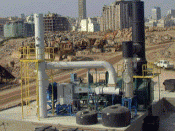System for Incineration of Solid Wastes Introduction The demands of modern society create wastes, which is increasing as the standard of living is increasing. The most effective way of dealing with the problem is to reduce the amount of waste generated. This will mean process modification or generating markets for waste stream, or recycling recovery etc. All efforts are being taken in industry and public to reduce the waste, but it will not be possible to eliminate waste totally.
Environmental regulations and many other factors make it more than necessary to ensure that the contaminated and non Bio-degradable materials are no longer tipped on the rubbish heaps. These materials have to be cleanly and effectively disposed.
In this article we shall discuss in detail about various types of Incinerators which are being used for waste disposal.
Options for waste disposal Ultimate disposal processes in use for waste disposal can be catagorised as "" (a) Deep well disposal (b) Landfill (c) Composting.
(d) Encapsulation (e) Ocean dumping.
(f) Dilute and disperse.
(g) Recycle and reuse.
(h) Incineration.
Incineration Incineration is used throughout the world as one of the optimum method for waste disposal. By incineration one can reduce the harmful potential of waste and possibly recover the heat available. The advantages of incineration are "" - The volume and weight of the waste are reduced to a fraction of its original size.
- Waste disposal is immediate.
- Waste can be incinerated at site.
- Air discharge can be effectively controlled.
- The ash produced is sterile.
- Complete destruction of most hazardous material is also possible.
- Small area is required.
- By heat recovery cost of operation can be reduced.
Some of disadvantages are - High capital cost.
- Requirement of skilled operators.
- All materials can not be...


